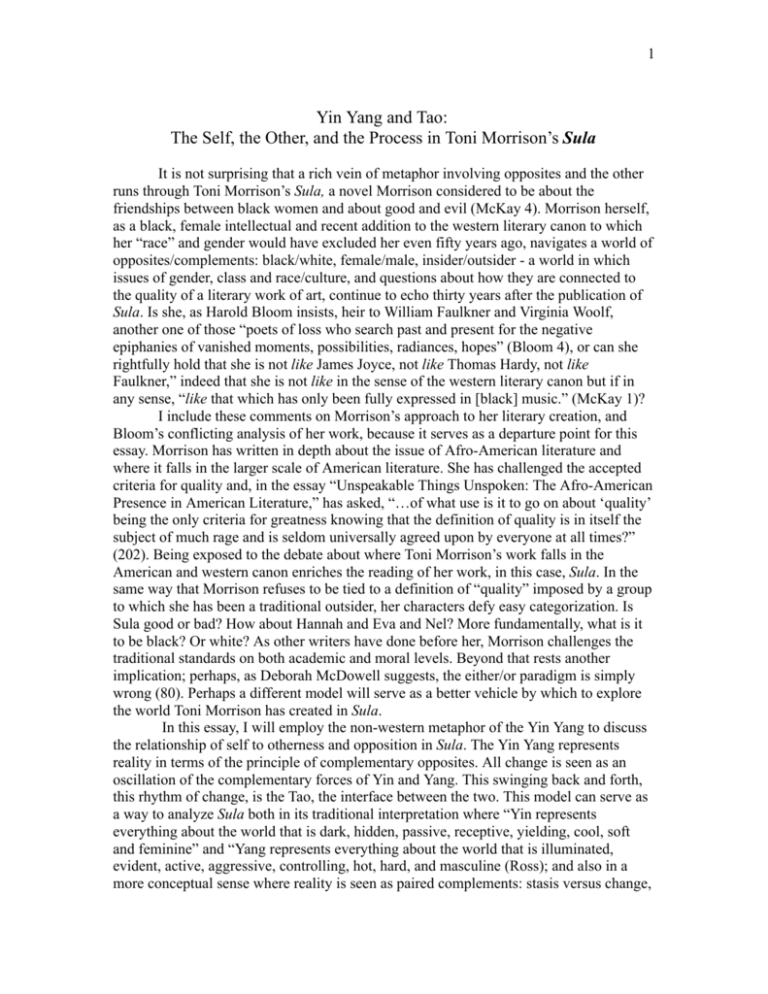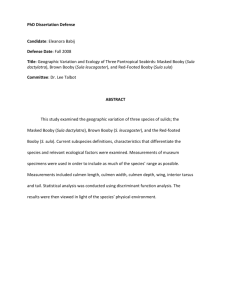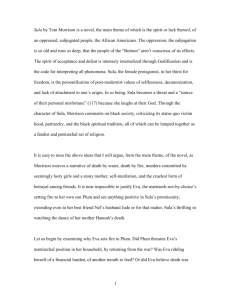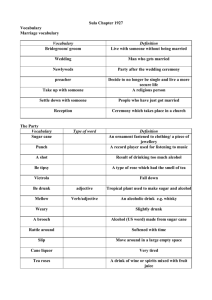Yin Yang and Tao: The Self, the Other, and the Process in Toni
advertisement

1 Yin Yang and Tao: The Self, the Other, and the Process in Toni Morrison’s Sula It is not surprising that a rich vein of metaphor involving opposites and the other runs through Toni Morrison’s Sula, a novel Morrison considered to be about the friendships between black women and about good and evil (McKay 4). Morrison herself, as a black, female intellectual and recent addition to the western literary canon to which her “race” and gender would have excluded her even fifty years ago, navigates a world of opposites/complements: black/white, female/male, insider/outsider - a world in which issues of gender, class and race/culture, and questions about how they are connected to the quality of a literary work of art, continue to echo thirty years after the publication of Sula. Is she, as Harold Bloom insists, heir to William Faulkner and Virginia Woolf, another one of those “poets of loss who search past and present for the negative epiphanies of vanished moments, possibilities, radiances, hopes” (Bloom 4), or can she rightfully hold that she is not like James Joyce, not like Thomas Hardy, not like Faulkner,” indeed that she is not like in the sense of the western literary canon but if in any sense, “like that which has only been fully expressed in [black] music.” (McKay 1)? I include these comments on Morrison’s approach to her literary creation, and Bloom’s conflicting analysis of her work, because it serves as a departure point for this essay. Morrison has written in depth about the issue of Afro-American literature and where it falls in the larger scale of American literature. She has challenged the accepted criteria for quality and, in the essay “Unspeakable Things Unspoken: The Afro-American Presence in American Literature,” has asked, “…of what use is it to go on about ‘quality’ being the only criteria for greatness knowing that the definition of quality is in itself the subject of much rage and is seldom universally agreed upon by everyone at all times?” (202). Being exposed to the debate about where Toni Morrison’s work falls in the American and western canon enriches the reading of her work, in this case, Sula. In the same way that Morrison refuses to be tied to a definition of “quality” imposed by a group to which she has been a traditional outsider, her characters defy easy categorization. Is Sula good or bad? How about Hannah and Eva and Nel? More fundamentally, what is it to be black? Or white? As other writers have done before her, Morrison challenges the traditional standards on both academic and moral levels. Beyond that rests another implication; perhaps, as Deborah McDowell suggests, the either/or paradigm is simply wrong (80). Perhaps a different model will serve as a better vehicle by which to explore the world Toni Morrison has created in Sula. In this essay, I will employ the non-western metaphor of the Yin Yang to discuss the relationship of self to otherness and opposition in Sula. The Yin Yang represents reality in terms of the principle of complementary opposites. All change is seen as an oscillation of the complementary forces of Yin and Yang. This swinging back and forth, this rhythm of change, is the Tao, the interface between the two. This model can serve as a way to analyze Sula both in its traditional interpretation where “Yin represents everything about the world that is dark, hidden, passive, receptive, yielding, cool, soft and feminine” and “Yang represents everything about the world that is illuminated, evident, active, aggressive, controlling, hot, hard, and masculine (Ross); and also in a more conceptual sense where reality is seen as paired complements: stasis versus change, 2 wholeness versus fragmentation, and one versus many. Thus, following the traditional example, I will explore how Sula completes Nel, and how Nel works as a foil, too, for Sula, and how the two, often embodying opposites, come together to form a whole. Moving from Sula and Nel, I will look beyond the traditional concrete pairs, of good and bad for example, or black and white, male and female, to the conceptual categories. Finally, carrying the model a last step, I will show how the connected idea of the Tao ties in. “Taoism sees all change as one opposite replacing the other”, as each force containing the seed of the other (Ross). In Sula, such a force can be seen at play with the contrasting pairs, from Sula and Nel, and Hannah and Helene, to the solitary and disconnected, as represented by Shadrack, and the community. This interplay between opposing forces starts with the first sentence of the book, as the natural world of nightshade and blackberry patches makes way for a golf course – for change and progress - and carries the reader through to the end. Fig. 1. The Yin Yang showing the dark, feminine Yin and the radiant, masculine Yang. Each force carries a seed of the other within it; the two combine to form a unity. From oneposter.com. The physical world that encompasses Sula and Nel is a good place to start and is itself one of opposing elements, with ambiguity built in linguistically at the start. The blacks of Medallion live in the “Bottom” at the top of the hills while the whites inhabit the valley. The truth of the origin of the town is both a joke and a travesty, and while the blacks literally look down on the whites, they continue to be oppressed. In this place, contradictions and ironies reign; love, goodness, race, and the integrity of the self are no longer definitive and the simplistic, one-sided interpretation of reality is challenged. Here a mother can both cherish and murder her offspring, as when Eva sets fire to Plum, or, though crippled, can jump out of a window to save the daughter she has just found it hard to admit she loves. Here the time of year is marked by Suicide Day, when the specter of death follows the living. Here we find being and nothingness as a shell-shocked man looks for his reflection in a toilet bowl as proof that he exists. Here a pale-skinned man is called Tar Baby and a woman with “custard” skin is black. “It is a world of paradox and ambiguity, a world where the ‘Bottom’ is situated at the top, a world that demands a shift from an either/or orientation to one that is both/and…” (McDowell 80). In this world two young girls begin the journey towards womanhood, one, Nel, exchanging a connection to her mother for one with a friend, and the other, Sula, more a seeming unity within herself. From the moment Nel recognizes herself as separate from her mother, when she whispers to herself for the first time, “I’m me,” she is drawn to the 3 other of Sula. Though “Each time she said the word me there was a gathering in her like power, like joy, like fear,” her new found me-ness serves not to set her on a path to independence but to give her “the strength to cultivate a new friend in spite of her mother” (28-29). Sula, on the other hand, is unencumbered by any sense of responsibility or even affection towards her mother or grandmother. She watches the former burn to death with a detached interest and commits the latter to “incarceration” in an old-folks’ home. In both Nel and Sula, however, the mark their mothers leave on them is significant; Nel’s mother Helene, though a proud and impressive matriarch in her community also shows “an eagerness to please and an apology for living” in the larger white world. In escape from the red-shuttered Sundown house and the Creole whore that was mother to her in name only, she finds safety in marriage to a man named “Wright” and comfort and purpose in raising Nel. Her dread of the “wild blood” of her mother will be passed down to Nel. In contrast, Sula’s mother, Hannah, like the other Peace women, “loved all men” and “simply refused to live without the attentions of a man” (41-42). Hannah’s promiscuity marks her as ‘bad” while Helene, from a conventional viewpoint, is “good.” Here, though, is a first instance of the binary either/or logic breaking down. As McDowell points out, “the novel invokes oppositions of good/evil, virgin/whore, self/other, but moves beyond them, avoiding the false choices they imply and dictate” (80). Hannah and Helene are freed from the rigid opposition of good/bad, and both resist interpretation as any one thing, just as Sula, and eventually even Nel, will be freed from the same restraint. Following the Yin Yang model, where the seed of the other is resident in the one, in Helene’s own studied goodness lies the dormant but threatening sexual licentiousness of her own maternal line. Carrying the device of opposition further, this maternal influence and its importance to how the girls have been formed and the personalities they develop is underscored by the homes they come from; Nel’s home is one of “oppressive neatness” while Sula’s is a “wooly house” of many rooms, some of “which were inaccessible from any other part of the house,” while others could only be accessed by going through somebody’s bedroom (30). That each finds pleasure and a sense of belonging in the home of the other becomes a metaphor for finding the missing elements in their own personalities that are necessary for completeness. “Nel, who regarded the oppressive neatness of her home with dread, felt comfortable in it with Sula,” who would “sit on the red velvet sofa for ten to twenty minutes at a time - still as dawn” (29). The order, chasteness and quiet submission that results in Nel will find its complement in the disorder, promiscuity and brazenness that emerges in Sula. The homes serve, too, as a nice metaphor for the personalities of Nel and Sula, and it is significant that some of the rooms in Sula’s house are only accessible through somebody’s bedroom; Sula will become intimate with herself through sex while Nel will lose her own identity through it. Such disparity in their backgrounds and personalities serves like a magnet to bring Nel and Sula together. “They found relief in each other’s personality” and the quality one lacked could be provided by the other. While “Nel seemed stronger and more consistent than Sula, who could hardly be counted on to sustain any emotion for more than three minutes” (53), she also finds through her friendship with Sula the “sparkle and sputter” that her parents have managed to rub “down to a dull glow…Only with Sula did that quality have free reign” (83). For her part, Sula, again, more a seeming unity in herself, continues to serve as a complement for Nel throughout the novel, rather than requiring 4 any element inherent in Nel to complete her. When Sula returns to Medallion after an absence of ten years, Nel reflects that her presence “was like getting the use of an eye back.” Indeed, she recognizes then that “Sula never competed; she simply helped others to define themselves” (95). Still, though Sula strives to be complete in herself, a one independent of others, she recognizes the value of the other. Even as she dies, she thinks, “Wait’ll I tell Nell. (149). Indeed, for all her independence, it is the very conformity of Nel, and the town, that provides a force for Sula to rebel against, the foil against which her own identity is defined. McDowell sees Nel and Sula as two distinct parts, but rather than being opposites they are complements to one another. They must be seen as different but connected. In fact, McDowell sees the two characters flowing into each other (82). At times they act in unison and seem to be of one mind, as when they bury “all of the small defiling things they could find” in the hole they have dug while playing in the grass, an activity that presages their dual implication in Chicken Little’s death. Moreover, their reactions to Chicken’s drowning illustrate this flowing into one another; it is Sula, who impassively watched her own mother’s painful death, that collapses in tears and feels a terror that Shadrack has witnessed the event, not Nel. Nel becomes the stoic one who quiets the other, and in this instance, supplies a missing element in Sula, a coherence and self-control. Nel will also later remember “The good feeling she had had when Chicken’s hands slipped,” and ask herself “Why didn’t I feel bad when it happened?” (170). It is interesting at this point to apply the traditional characteristics of Yin and Yang to Nel and Sula and see if they fit. Certainly Nel embodies the Yin in her conventional feminine behavior; “Except for an occasional leadership role with Sula she had no aggression” (83). She is passive and yielding; her most intimate knowledge of herself is dark and hidden from her. Even on her wedding night with Jude, “The veil she wore was too heavy to allow her to feel the core of the kiss he pressed on her head” (85). Though she revels in “the new feeling of being needed by someone who saw her singly,” she will lose any identity she has with Jude and serve only to complete him. In contrast, Sula bears the masculine traits of strength and aggression, and sexual variety. Even in a submissive sexual position under a man whose name she cannot remember, she feels “her own abiding strength and limitless power” (123). Far from hidden, everything about her is evident, and though her incapacity for subterfuge makes her an open target in the town, she “wants to touch life with an ungloved hand” (121). Sula is dazzling, hot, and hard from the way she dresses to the way she talks to the way she takes men for her pleasure. “Whatever’s burning in me is mine,” she tells Eva. Other symbols of Sula fit in with this, such as the birds that herald her return, Appollian things of the air signifying flight and freedom. That a water metaphor is often applied to Sula in the novel does not disrupt the model here; it provides an instance of that seed of the other that exists in everything. One area where this connection of Sula to water comes into play is in the issue of gender. Morrison has said, in as essay appearing in the collection The House That Race Built, that in Sula she “was preoccupied with the culture of gender and the invention of identity” and that both acquired astonishing meaning when placed in a racial context” (9). In the characters of Nel and Sula, Morrison explores the relations between the sexes and questions traditional ideas of women’s role. Because Sula has not given in to the conventional expectations of marriage, an institution that Morrison equates with the “death of the female self and imagination” (McDowell 154), she is able to replace the usual either/or reality for one of both/and. She can be at once feminine and masculine, 5 soft and hard, dry and wet. When she enters into a relationship with Ajax, though union with him fills her with a sense of her own power, it also brings on a “weakness she felt under her skin” (130) and she thinks in terms of moisture and soil: “I will water your soil, keep it rich and moist. But how much? How much water to keep the loam moist? And how much loam will I need to keep my water still?” (131). Sex in the character of Sula becomes an elemental question, one outside the bounds of social convention or moral absolutes, one of water and earth, not marriage and the societal expectations that come with it. On the conceptual plane, where we apply the Yin Yang model to the qualities of stasis versus change, wholeness versus fragmentation, and one versus many, we can now see how these complementary oppositions are embodied in Nel and Sula. Nel’s preoccupation with being “good” illustrates what McDowell calls her “limited response”. She considers herself a “good woman” when she visits the dying Sula and “Virtue, bleak and drawn, was her only mooring” (139). In the way she ties herself to one narrow definition of her being, she cuts off all possibility of change or adaptation to circumstances. Indeed, for Nel, change is hell. In contrast, “Sula is an ambiguous character with a repertoire of responses along a continuum” (McDowell 84). She resists rigid categorization and vehemently responds when Nel tells her, “You can’t do it all. You a woman and a colored woman at that. You can’t act like a man” (142). Wholeness for Sula does not mean limitation or the amputation of parts of herself. When she replies to Nel that being a woman and colored “is the same as being a man” she is embracing possibility. Recognition and acceptance of the multiple elements of her personality allows Sula to say, even as she is dying, that she “sure did live in this world” as opposed to other colored women who allow their condition to lock them into a static state of dying. In like manner, Sula refuses to be locked into the rigid definition of good and bad that is imposed on her, and on Nel, by others. “‘How you know’ Sula asked…’About who was good? How you know it was you...Maybe it was me’” (146). Ultimately this rejection of the traditional notions of good and bad allows Sula to die at peace with herself, a oneness composed of a mosaic of vivid qualities and experiences. In a last poetic reflection, Sula recites a litany of seeming opposites and absurd pairings and she knows, when they come to pass, “there’ll be a little love left over” for her in the restrictive community which has rejected her. Sula can conceive of a dynamic world, one where “Norma Shearer makes it with Stepin Fetchit,” one where the two distinct parts are not locked in separate realities; unlike Nel, for Sula “The real hell of Hell is that it is forever” (107), that there is no change. Sula’s death reveals the one-sidedness not only of Nel’s reality, but of the town’s as well. In their limited interpretation of her as “bad,” the townspeople have failed to realize that wholeness, (wholesomeness, too,) depends on an interplay of opposites, as much individually as collectively. Nel gets some glimmer of this truth upon Sula’s return to the town, when she realizes that Sula’s presence allows her to feel “clever, gentle, and even a little raunchy” (95), but it is not until Sula’s death that the full importance of this blend of complimentary qualities is felt. Even before the final realization that it is Sula, and how Sula completes her, that she has been missing, and not Jude, she undergoes a change. In reflecting upon the past, she drops her rigid criteria of good and bad to admit of the possibility of good whores versus bad, shameless ones versus those “nasty but shamed” modern ones who were always embarrassed. As for the townspeople, Sula’s 6 death deprives them of anything “to rub up against. The tension was gone and so was the reason for the effort they had made” (153). The result is a deterioration of the community. As Sula has helped Nel to define herself, so she has helped the town to define itself. But even more; in the same way that Sula’s death acts as a catalyst for Nel’s self-discovery, a self exploration that includes a coming to terms with her complicity in Chicken Little’s death and her own capacity for bad as well as good, so the town is forced to recognize the dual nature of its own reality. When Eva says to Nel, “You, Sula. What’s the difference?” she could just as well be saying it to them all. While there are distinct oppositional pairings then, in Sula, there is also flow and change, and what McDowell discusses in terms of process; “As with Nel, that process begins with releasing the static and coherent conception of self and embracing what Sula represents: the self as process and fluid possibility” (85). Thus Nel, who can be seen to represent limitation and stasis, by the end of the book, shows a new self-knowledge and some capacity for change. Others in the town experience a similar release, such as the solitary Shadrack, who, “for the first time since that cold day in France … was beginning to miss the presence of other people” (155), and who the reader senses may finally be able to embrace life and not the death he has lived with for twenty years. The “Bottom” itself undergoes a reversal with the rich whites moving up into the hills and the poor blacks moving down into the valley. The community, a cohesion, breaks apart until all that remains are “separate houses with separate telephones” (166). The Yin becomes the Yang and the Yang becomes the Yin. Further, this process, this shifting, can be conceived in terms of the Tao; to recall, “Taoism sees all change as one opposite replacing the other” (Ross), and “Behind the bewildering multiplicity and contradictions of the world lies a single unity, the Tao” (Hooker). Rich and poor, black and white, restrictive and embracing, oneness and multiplicity; all shift and settle into a new whole, a refigured Yin Yang where the Tao, the process of becoming and passing away, “gives rise to all existence and governs everything, all change and all life” (Hooker). Like Nel’s cry at the end, it is a world with no bottom and no top, or rather, one where top and bottom reverse, one where all that remains are “just circles and circles of sorrow” and all the other elements of what it is to be human and alive. 7 Works Cited Bloom, Harold. Introduction. Modern Critical Views: Toni Morrison. Ed. Harold Bloom. Philadelphia: Chelsea, 1999. 1-5. Hooker, Richard. “A Chinese Philosophy: Taoism.” 1996. World Civilizations: An Internet Classroom and Anthology. Washington State University. 1 March 2005 <http://www.wsu.edu:8080/~dee/CHPHIL/TAOISM.HTM >. McDowell, Deborah. “‘The Self and the Other’: Reading Toni Morrison’s Sula and The Black Female Text.” Critical Essays on Toni Morrison. Ed. Nellie McKay. Boston: G. K. Hall, 1988. 77-88. McKay, Nellie. Introduction. Critical Essays on Toni Morrison. Ed. Nellie McKay. Boston: G. K. Hall, 1988. 1-14. Morrison, Toni. “Home.” The House That Race Built. Ed. Wahneema Lubiano. New York: Vintage, 1998. 3-12. - - - . Sula. New York: Plume, 1982. - - - . “Unspeakable Things Unspoken: “The Afro-American Presence in American Literature.” Modern Critical Views: Toni Morrison. Ed. Harold Bloom. Philadelphia: Chelsea, 1999. 201-230. Ross, Kelley. “Yin & Yang and the I Ching.” The Proceedings of the Friesian School. Ed. Kelley Ross. 2005. 1 March 2005 <http://www.friesian.com/yinyang.htm>






